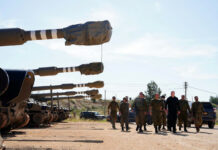
They worked for decades to keep the Francis Scott Key Bridge from falling into the water.
After the World Trade Center’s twin towers were destroyed by hijacked airplanes, Maryland transportation officials worried that the Baltimore span – known to those testing its durability as Bridge No. BCZ472 – could be taken down by terrorists. Transportation police bought boats to patrol around bridge piers in the state.
After a bridge carrying Interstate 35 motorists over the Mississippi River collapsed in Minneapolis in 2007, Maryland inspectors rushed to examine the Key Bridge, hunting for similar design errors and other weaknesses that could lead to catastrophe.
Then, this week, a ship hit it.
For 47 years, Maryland inspectors and safety officials had spent many thousands of hours and millions of dollars inspecting, prodding and protecting the 9,090-foot-long bridge, trying to keep it strong amid the onslaught of time, weather and vehicles. But state officials worried about terrorism had focused on bombs and bad guys in small boats, not an errant 95,000-gross-ton container ship, according to a former official with the Maryland Transportation Authority, the independent agency that runs the Key Bridge and the state’s other tolled bridges, highways and tunnels, and a former senior state transportation official.
“The assumption was a truck bomb or something like that,” the former senior transportation official said.
And after Minneapolis, the focus wasn’t on building the kind of massive and costly barriers that might have had even a chance of stopping a ship like the Singapore-flagged Dali from sending the Key Bridge crumpling into the Patapsco River, said the former senior transportation official.
“It never occurred to anybody,” he said.
Both former officials requested anonymity to speak candidly about the bridge, which is now part of a federal safety investigation. The Maryland Transportation Authority and the Maryland Department of Transportation did not respond to questions about bridge safety or provide requested information.
Before the Key Bridge this week became the focus of international attention, it was just Bridge No. BCZ472 (and later, per federal naming conventions, Bridge 300000BCZ472010.) With just over 30,000 vehicles a day, it’s not the state’s busiest. It wasn’t on a transportation industry list of the worst Maryland bridges.
In 2008, its rating in the Federal Highway Administration’s bridge inventory, covering things like its piers and foundation, fell from good to fair. Its main steel support structures also started getting lower marks. But the bridge was still better than poor. It was deemed “satisfactory.”
In an interview last month on state transportation challenges, Maryland Transportation Secretary Paul J. Wiedefeld noted the need to address the traffic-clogged, six-decade-old American Legion Bridge on the Capital Beltway. And his thoughts went to the recent pileup of dozens of cars on the Chesapeake Bay Bridge, which was caused by an erratic driver and treacherous weather and underscored long-standing safety concerns for the millions of people who use it. The state has been eyeing plans to build a new span nearby, but costs could be astronomical.
Wiedefeld didn’t mention the Key Bridge. There was no reason to.
Before one of its critical piers was knocked out, sending the bridge tumbling into the water and bringing tragedy to the families of the workers who were there to fix its potholes, Bridge No. BCZ472 was just another piece of aging but functional American infrastructure.
The Key Bridge was one of 17,468 “fracture critical” bridges in the United States, said Jennifer Homendy, chair of National Transportation Safety Board, which is investigating the incident. That means if one key piece fails, part or all of the bridge would likely collapse.
“The preferred method for building bridges today is that there is redundancy built in,” Homendy said this week. “This bridge did not have redundancy.”
NTSB investigators have asked Maryland officials to provide extensive information on 10 years’ worth of fracture-critical, routine and underwater bridge inspections. Homendy also indicated investigators are taking a broader view of an issue that has received attention since the collision: the presence and role of any structures meant to protect the bridge from impacts. Investigators have asked Maryland for information on “pier protection” for all four Maryland Transportation Authority bridges.
“We are looking at that,” she said.
Outside transportation experts said this incident does not appear to have been a matter of insufficient inspection or maintenance. Even if both were perfect, bridge engineers said, that would not change the physics involved with a ship that heavy and a bridge that vulnerable.
Whether Maryland transportation officials should have foreseen such a risk and whether other states should learn lessons from its example are among the questions likely to be explored in connection with an investigation the NTSB said could take up to two years.
Some transportation safety and engineering experts said it was not an easy call whether to build small island-like barriers to protect the bridge piers. Something too modest, and it wouldn’t have made a difference; something too big, and it could have created new problems in an economically vital waterway connecting the Port of Baltimore to the world.
“That’s a pretty tight channel,” the former senior transportation official said. “You might actually create a hazard rather than mitigate one.”
Rachel Sangree, a bridge engineering expert at Johns Hopkins University, likewise said she was “not sure that something could have practically been constructed to withstand that direct hit.”
American infrastructure has been underfunded for decades. An infrastructure law passed by Congress with bipartisan support and signed by President Biden in 2021 is making a dent in that deficit, but key transportation projects are still beset by financial challenges.
Weighing what to prioritize can be complicated. An ongoing project to build 80-foot-wide cylinders designed to protect the Delaware Memorial Bridge from ever-larger container vessels will cost nearly $93 million. A 2022 Maryland freight investment plan included a proposal to spend $86 million to replace the concrete deck and important barriers on the Key Bridge. Such immediate safety-related fixes might have seemed more urgent than protecting bridges from hypothetical collisions.
Roberto T. Leon, a structural engineering professor at Virginia Tech, said bridge engineers wrestle with how to handle “high-consequence rare events” such as this week’s accident.
“You buy safety at a certain cost,” Leon said, adding that the price of addressing very unlikely threats can soar. And even as engineers, and society, learn lessons and increase safety standards over the decades, some projects with known safety vulnerabilities are allowed to stay in operation.
“We change things,” Leon said. “But we have to grandfather existing structures because the cost of bringing things up to date would be enormous.”
Infrastructure lasts a very long time. The nation is still dotted with projects dating back to Franklin D. Roosevelt’s presidency. And when infrastructure fails, the consequences can be deadly.
The Key Bridge opened in 1977. Three years later, a cargo ship crashed into the Sunshine Skyway Bridge in Tampa Bay, causing the span to collapse and kill 35 people. The NTSB said in a report at the time that highway authorities and the Coast Guard should identify existing and proposed bridges “in need of additional protection from ship collisions and issue standards for the design, performance, and location of structural bridge pier protection systems.”
The American Association of State Highway and Transportation Officials later issued bridge design specifications that covered vessel impacts. But that didn’t require a major retroactive overhaul of the Key Bridge.
Maryland officials should have moved aggressively to protect their bridges from collisions, despite the costs, said attorney Steve Yerrid, who represented the pilot of the ship involved in the Florida crash.
“They had all this time to realize the danger, and it appears to me they did nothing about it,” Yerrid said.
At the time of the Sunshine Skyway Bridge accident, the Baltimore Sun reported that a top state engineer said the Key Bridge couldn’t withstand a similar collision. “I’m talking about the main supports, a direct hit – it would knock it down,” the official said.
The deaths of the men who were the last to try to improve the bridge have been wrenching, the former senior transportation official said. “It’s hard to convey how deeply personal this is for all of us,” he said.
A satellite photo taken by imagery firm Planet last year and provided to The Washington Post shows four white dots in the Patapsco River, located across from the piers holding up the bridge. Those barriers are meant to increase safety, according to the former Maryland Transportation Authority official.
“They were put in there to keep ships in the channel,” he said. “If you keep a ship in the channel, you’re not going to hit anything.”
A second satellite image from Tuesday showed the Dali had easily slipped past one of the white barriers, sometimes referred to as “dolphins,” before ramming into the Key Bridge.
The Maryland Transportation Authority issued a traffic alert soon afterward.
“I-695 Key Bridge has collapsed due to ship strike,” it said.
(c) 2024, The Washington Post · Michael Laris, Peter Hermann












Please see the video at:
https://www.brighteon.com/d62d0c97-bd62-46f9-bdf3-72e657b304cc
“Bridge Collapse: Nothing Adds Up” Which relates that there are numerous items in the so-called “official” “mainstream” narrative that are extremely, extremely suspicious.
Please further see the video at:
https://www.brighteon.com/0d65c026-126f-4937-984a-9d9913fce1d6
“BRIDGE RIGGED WITH EXPLOSIVES!!” Which points out the explosives on the bridge exploding.
Please further see the similar video at:
https://www.brighteon.com/9e8087bc-9867-485a-974c-f9df092ae7ea
“BRIDGE BLOWN UP!! BOAT WAS A COVER, PLANES TWIN TOWERS. SAME PLAYBOOK!!” “It was an inside job they blew the bridge, that’s why they don’t want video footage put out by the press. The boat was a cover for them to blow the bridge, just like (in the attacks of 9/11) the planes hitting the twin towers was a cover to blow up the building. Same playbook again. What you have to ask is why? And who benefits?”
Please also see the video at:
https://www.brighteon.com/f8c38591-671d-46a6-bcc3-e565762b2c13
“HOW THEY BELW UP BRIDGE!!” This shows how they actually attach explosives to a bridge.
WE TOLD YOU IT WAS A FALSE FLAG FROM DAY #1.
They should have listened to ABC News 5 hours before it happened and nobody would’ve been killed. (Like the BBC that reported the 9/11 attack 20 minutes before it happened.)
The ship didn’t cause the bridge to collapse in controlled demolition, like the WTC there were explosives all around the ship.
They should have listened to ABC News 5 hours before it happened and nobody would’ve been killed. (Like the BBC that reported the 9/11 attack 20 minutes before it happened.)
The ship didn’t cause the bridge to collapse in controlled demolition, like the WTC, there were explosives all around the ship.